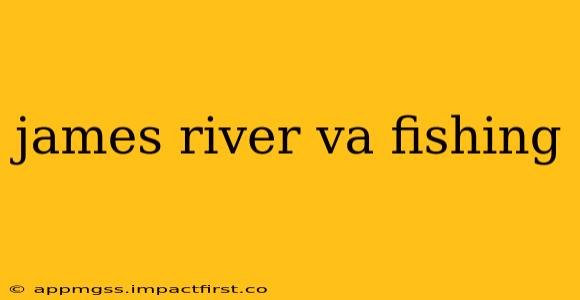The James River in Virginia offers a diverse and rewarding fishing experience, attracting anglers of all skill levels. From its headwaters in the Appalachian Mountains to its broad estuary meeting the Chesapeake Bay, the river boasts a remarkable variety of fish species and habitats. This guide delves into the best fishing spots, target species, techniques, and regulations to ensure a successful and enjoyable fishing trip on the James.
What are the best places to fish on the James River?
The James River's diverse ecosystem provides numerous excellent fishing locations. The best spot depends heavily on your target species and preferred fishing style. Popular areas include:
- The James River Gorge: Known for its challenging whitewater and excellent smallmouth bass fishing. Access points vary, and experienced anglers are recommended.
- Cartersville Area: This section offers good access and is popular for a variety of species, including largemouth bass, catfish, and sunfish.
- Richmond Area: While impacted by urbanization, the river still holds good fishing opportunities, particularly for catfish and various panfish. Specific locations within the city limits may have restricted access or regulations.
- The Chickahominy River: A major tributary of the James, the Chickahominy offers excellent fishing opportunities, particularly for largemouth bass and striped bass.
- The lower James River (towards the Chesapeake Bay): This area is a prime location for saltwater species like striped bass (rockfish), flounder, and various other migratory fish.
What kind of fish can you catch in the James River?
The James River supports a wide range of fish species, making it a truly diverse fishing destination. Some of the most commonly caught include:
- Largemouth Bass: A popular game fish found throughout the river's length.
- Smallmouth Bass: Thriving in the faster-flowing sections, particularly in the upper James.
- Striped Bass (Rockfish): Abundant in the lower James River and estuary, particularly during their migratory runs.
- Catfish (Channel Catfish, Blue Catfish): Found throughout the river, especially in deeper, slower-moving waters.
- Sunfish (Bluegill, Redear Sunfish): Excellent panfish options readily available in many areas.
- Crappie (Black Crappie, White Crappie): Found in various habitats throughout the river system.
- Other Species: The James also holds various other species, including carp, gar, and various species of minnows.
What is the best time of year to fish in the James River?
The ideal time to fish the James River depends significantly on your target species:
- Spring: Excellent for largemouth bass and other warm-water species as they become active after winter. Striped bass are also moving upstream.
- Summer: Ideal for catfish and other species that thrive in warmer water.
- Fall: Another excellent time for bass fishing, as they prepare for winter. Striped bass migrations also occur during this period.
- Winter: Fishing can be slower, but some anglers still find success targeting catfish and other cold-water species.
What are the fishing regulations for the James River?
Fishing regulations in Virginia are strict and enforced. It is crucial to familiarize yourself with the current regulations before you go fishing. These regulations cover:
- Licenses and Permits: You will need a valid Virginia fishing license.
- Size and Creel Limits: Specific size and quantity restrictions apply to various species.
- Fishing Methods: Certain fishing methods may be restricted or prohibited in specific areas.
- Seasonal Closures: Some species have closed seasons to protect their populations.
Consult the Virginia Department of Wildlife Resources (DWR) website for the most up-to-date regulations. Failure to comply can result in significant fines.
What are the best fishing techniques for the James River?
The best fishing techniques will vary depending on your target species and location:
- Bass Fishing: Techniques like topwater lures, crankbaits, spinnerbaits, and plastic worms are effective for bass.
- Catfish Fishing: Bottom fishing with live bait (like worms or minnows) or stink bait is often successful.
- Striped Bass Fishing: Casting lures or trolling are effective methods for striped bass, particularly in the lower James.
What kind of equipment do I need for fishing in the James River?
The necessary equipment will depend on your target species and fishing style. Generally, you'll need:
- Rod and Reel: Choose appropriate gear based on your target species.
- Line: Select line strength appropriate for the fish you're targeting.
- Hooks and Lures: A variety of lures and bait is recommended to increase your chances of success.
- Tackle Box: For storing your hooks, lures, sinkers, and other essentials.
- Waders (optional): Useful for accessing certain areas, especially in the upper James.
Remember to always practice responsible fishing and adhere to all regulations. Enjoy your fishing experience on the beautiful James River!
